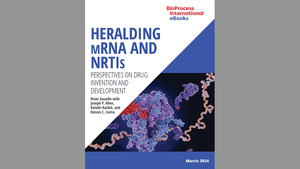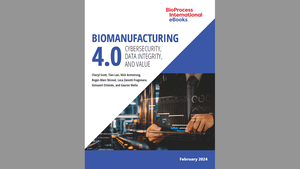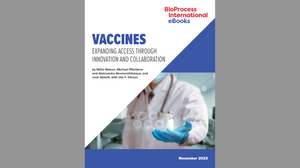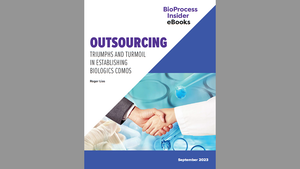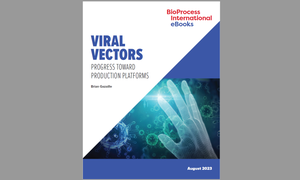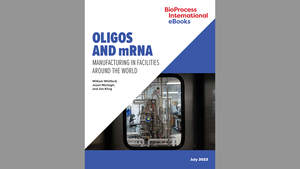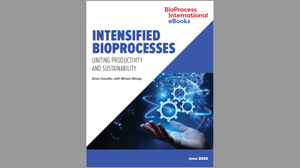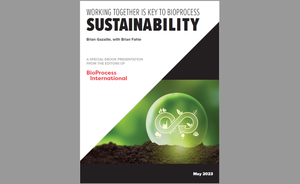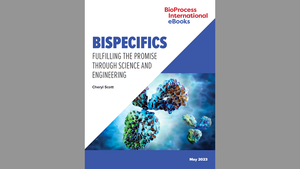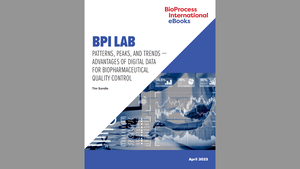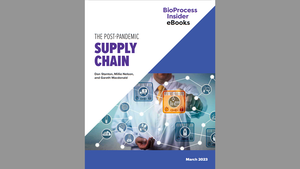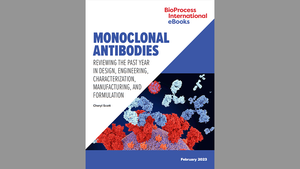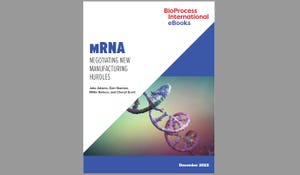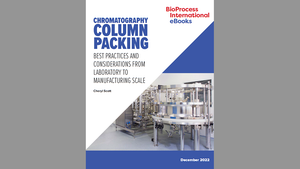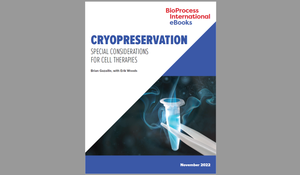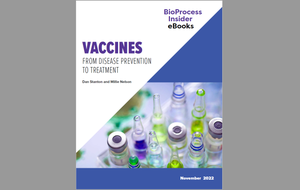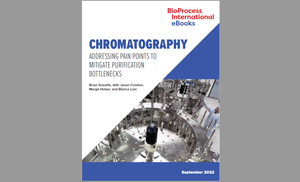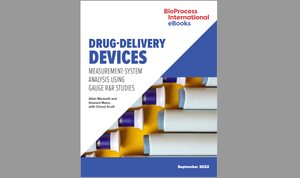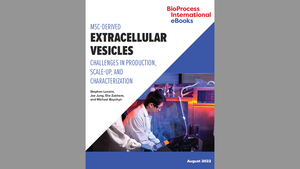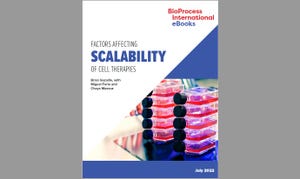South Korea’s biopharmaceutical manufacturing industry is booming, thanks in part to major capital expenditure projects from Samsung Biologics, Celltrion, and others driving growth and development. The sector began growing in the wake of the 2008 global economic crash, and since 2012, the size of the country’s pharmaceutical industry has been on a steady upward trajectory, with a market currently valued at over US$22 billion. In this eBook,
BioProcess Insider’s
founding editor Dan Stanton highlights regional hot spots and shows how government support has helped them grow. He also delineates the relationship between supplier/vendor support for the broader region and how major companies are using that to their advantage. Then, Millie Nelson reports on the South Korean delegation to JP Morgan’s February 2024 Healthcare Conference in San Francisco, where Celltrion, Lotte Biologics, SK Bio, and Samsung Biologics touted their latest facility investments, business expansions, and product success.
Fill out the ...
Through the acquisition of Spark therapeutics in 2019, Roche propelled itself into gene therapy space and hasn’t looked back. Reporting from the December 2023 Cell & Gene Therapy Manufacturing & Commercialization Europe conference in Ireland, this eBook addresses the production of next-generation adenoassociated virus (AAV)–based products. Specifically, the Swiss biopharmaceutical giant hopes to break through the manufacturing limitations that have limited the reach of such lifesaving treatments. Roche wants to create a range of gene therapies that can treat large patient populations at affordable prices.
BioProcess Insider
also brings you the latest trends in AAV-based gene therapy news.
Fill out the form below to read the full eBook now.
Messenger RNA (mRNA) and nucleoside reverse-transcriptase inhibitors (NRTIs) represent two of today’s most discussed pharmaceutical modalities. The former drug class has become a household name because of its critical role in ameliorating the COVID-19 pandemic. People outside of the pharmaceutical industry are probably less familiar with NRTIs — although maybe more so with Biktarvy (emtricitabine), the blockbuster small-molecule drug developed in the thick of the human immunodeficiency virus (HIV)/acquired immunodeficiency syndrome (AIDS) pandemic. At first glance, mRNA-based vaccines and emtricitabine might seem to be a strange pairing for discussion. But a closer analysis reveals shared scientific, business, and legal challenges that the drugs’ inventors needed to overcome to bring such products to millions and even billions of people worldwide.
In this eBook, BPI’s managing editor speaks with Nobel Prize laureate Katalin Karikó (coinventor of nucleoside-modified mRNA technology) and Dennis C. Liotta (c...
Regulatory compliance cannot be an afterthought when you apply artificial intelligence, machine learning, and other advanced information technologies to biopharmaceutical development and manufacturing. The authors in this eBook encourage readers to keep product quality (as well as business concerns) in mind, using agile methodologies and good automated manufacturing practices while embracing the bioprocess 4.0 paradigm. As the industry takes its IT to the next level, smart planning and critical thinking are vital to success. First, the editor in chief highlights issues related to cybersecurity. Then, authors from PGE Group illustrate how GAMP 5 and agile/critical thinking apply to computer system validation — and why they are important to product quality. Nick Anderson encourages companies to apply lessons learned from pandemic collaborations toward a cooperative approach to supply chain logistics in a postpandemic world. Roger-Marc Nicoud urges an engineering approach to bioprocess simulation strategy. ...
Between 2000 and 2019, the US Food and Drug Administration (FDA) approved only four antibody–drug conjugate (ADC) products for commercial distribution. Between then and 2024, however, the number of marketed ADC products has swelled to 13, and clinical studies are underway for more than 100 candidates that address nearly 40 indications, mostly in oncology. Recent successes might seem to have come suddenly considering the previous dearth of approvals. But drug companies in the ADC space have worked steadily both to improve available linker chemistries and conjugation methods and to devise new methods and materials. Equally important is that current developers have been able to draw from a deep well of institutional knowledge about what methods and materials would work best for a given antibody and payload.
This eBook presents interviews with two pharmaceutical executives to survey the current ADC landscape and imagine future pathways for discovery and development activities. First comes a discussion with Da...
The rapid global response to the COVID-19 pandemic showed how remarkably fast vaccine development can be with a coordinated effort from biopharmaceutical companies, government organizations, regulatory agencies, and public institutions. Although some of the world’s most prolific diseases are more complex than COVID-19 coronavirus, growing infrastructural and financial support are enabling scientists to make breakthroughs in diseases that seemed insurmountable only a decade ago in underserved regions around the world. And with accelerated discover times thanks to advanced technologis such as artificial intelligence (AI) and machine learning (ML), the future of vaccines has never been more promising. In this eBook,
BioProcess Insider’s
Millie Nelson overviews the state of vaccine manufacturing in Africa, highlighting significant investments, facilities, and developments. Next, BioProcess International’s Josh Abbott discusses malaria vaccine development, manufacturing, and distribution with the director o...
Assay development doesn’t end with a validated analytical method. Changes are made as a biopharmaceutical product continues through development. Often that progress includes transfer from the original laboratory to another. Whether a project is outsourced or scaled up in house, analytical methods such as bioassays must be transferred to new laboratories, with different personnel and often different equipment setups. Making sure they can repeat that validated method with equivalent results is key to both regulatory compliance and product safety and efficacy. The author of this eBook provides a stepwise strategy for doing so, from risk assessment through preparation, training, protocol preparation, and establishing criteria, to report preparation based on ALCOA+ principles. She also demonstrates how analytical method transfer plays a pivotal role in driving business growth, enabling biopharmaceutical companies to expand their production capabilities and explore new markets while ensuring consistency and rel...
Biopharmaceutical products must be sterile. Protein biologics and now advanced-therapy medicinal products (ATMPs) usually are administered in ways that bypass patients’ natural immune defenses. Therefore, such drugs increase risks for introducing contamination to their recipients. Because terminal sterilization can destroy biological products, aseptic manufacturing is the primary means for ensuring drug-product sterility. However, aseptic processing involves many more variables than does terminal sterilization, making it imperative for drug manufacturers to keep abreast of emerging techniques for aseptic processing and evolving regulatory guidances.
In this eBook, a commissioning, qualification, and validation (CQV) subject-matter expert from regulatory consultancy PharmaLex provides valuable impressions from the 2023 International Society for Pharmaceutical Engineers (ISPE) Aseptic Conference in Bethesda, MD. The meeting convened presenters and delegates from the world over to discuss recommendations for...
Outsourced development and manufacturing once were all but out of the question in the biopharmaceutical industry. Regulatory changes, technical and scientific advances, and an increasingly global market have transformed a once-risky option into a common business strategy. This eBook brings a historical perspective and valuable advice from lessons learned through decades of experience. Well-known industry advocate and executive consultant Roger Lias highlights the challenges and keys to success on the service-provider side as the economic environment invites budding entrepreneurs to enter the fray.
Fill out the form below to read the full eBook now.
After decades of research and development (R&D) and despite more than a few clinical setbacks, viral-vector gene therapies finally are making headway into the marketplace. However, cost considerations still reverberate around the biopharmaceutical industry. Scientists recognize that nonoptimal manufacturing is implicated in the high prices for gene-therapy products. For instance, adenoassociated virus (AAV) and other such gene-delivery systems are produced at much lower scales than are monoclonal antibodies (MAbs) and other recombinant proteins — understandably so given the size and biological complexity of the vectors that need to be produced. Viable vectors also are recovered at far lower rates than their protein counterparts are. Hence comes the biopharmaceutical industry’s interest in identifying platform approaches to viral-vector production. The hope is that leveraging standardized methods and materials for large-scale vector production could help to reduce processing costs, decrease operational com...
Three years ago, mRNA biotechnology was poised to provide just what the world needed to fight SARS-CoV-2. Researchers already had been working to develop nucleotide therapies for cancers and infectious disease, and the pandemic gave companies an immediate proving ground for speeding up development and demonstrating what such technology could accomplish. Capitalizing on the resulting success, developers of mRNA and related oligonucleotides now are looking to the future and addressing a number of manufacturing challenges to ensure widespread access to such therapeutics around the world.
In this eBook, science writer Jim Kling provides an update on the state of the science and business of mRNA development. He highlights key manufacturing challenges, particularly those related to product stability, and talks to experts in industry and academia who are finding ways to address the problem of access for far-flung countries without the necessary infrastructure to protect finicky formulations. In South Africa, Afr...
Biopharmaceutical companies gradually are exploring options for process intensification (PI) and continuous manufacturing. Such strategies are known to increase process economics and decrease equipment footprints, both of which help to reduce cost of goods, capital expenditure, and operational costs. But as this eBook shows, most companies have yet to consider another critical driver for adopting intensified bioprocesses: sustainability.
Recent studies into the environmental impacts of monoclonal antibody (MAb) production processes have underscored the water intensity of biomanufacturing. In this eBook, BPI’s managing editor speaks with editorial advisor Miriam Monge (Sartorius) about how intensified bioprocesses can reduce water consumption, decrease equipment needs and associated cleanroom requirements, and more — all of which help to alleviate negative environmental impacts from biomanufacturing processes and facilities. Read the eBook to learn about different PI strategies for both upstream and downst...
Adding chimeric antigen receptors (CARs) to T cells makes them capable of recognizing and binding to target cells, with the first applications inciting patients’ immune systems to destroy malignancies. The speed with which CAR-T technology has progressed from discovery to approved therapies — and from a few academic researchers to hundreds of companies — reflects the power this modality has to revolutionize oncology. In some cases, a single treatment has led to complete (maybe even permanent) remission. And other applications are under investigation as well. Here, the founding editor of
BioProcess Insider
provides current perspectives from key individuals and organizations involved in the past, present, and future of CAR-T cell therapy. They highlight up-and-coming variations on the CAR-T theme, discuss the future of allogeneic and autologous approaches, and predict that ensuring lentivirus supply will be key to commercialization.
Fill out the form below to read the full eBook now.
Sustainability initiatives are launching across the biopharmaceutical industry as companies begin to scrutinize their environmental impacts as part of the growing environmental, social, and governance (ESG) movement in business. Achieving ambitious sustainability goals will require organizations to evaluate their raw materials, production processes, product packaging, operations, and supply and distribution chains — and such work will entail monumental effort. Herein, BPI managing editor Brian Gazaille speaks with Brian Fahie, head of analytical development at Biogen, about that company’s efforts to prioritize environmental concerns in its corporate culture and business dealings. A recognized leader of sustainability efforts in the biopharmaceutical industry, Biogen urges its fellow companies to take both a long-term vision and short-term approaches to establish sustainability momentum and keep it going. Reflecting on movements within his company, Fahie highlights the need for practicable, company-wide su...
With nine products already on the market, bispecific antibodies (bsAbs) are the most commercially advanced of all antibody-derivative biopharmaceuticals. But that isn’t to say that they face no obstacles to success. Indeed, as BPI’s senior technical editor finds in her review of recent literature and conference proceedings, the details of production and processing still confound many bsAb developers. With dozens of molecular formats in progress — and more arising all the time — the prospects for a platform process are few.
What companies need is an expanding toolkit of technical and scientific options to choose from, and suppliers of equipment, materials, and services are working hard to provide their own entries into that line-up. Top of the wishlist are methods for characterizing and monitoring product-related impurities such as malformed product variants and process-related impurities such as host-cell proteins. Although the latter can be addressed in ways familiar to many a monoclonal-antibody process...
Socrates said the unexamined life is not worth living. Similarly, data are useless without analysis. And even as artificial intelligence makes inroads into the biopharmaceutical industry, human insight remains important. Graphically representing data is more than just creating pretty pictures; proper data visualization can improve the communication of sometimes abstract information to make data accessible, understandable, and usable. Patterns and insights arise during the review process — whether data are intended for internal or external publication or for inclusion in a regulatory submission.
In this eBook, BPI editorial advisor Tim Sandle (head of microbiology at Bio Products Laboratory) presents some different approaches to presenting and studying biopharmaceutical laboratory data. Illustrations demonstrate different sorts of data sets and how their patterns can be revealed through visual presentation — as well as what can go wrong when the wrong choices are made.
Fill out the form below to read the f...
Supply chains felt the full force of the COVID-19 pandemic, leading the industry to rapidly adopt new protocols. Additional forces have also exposed the supply chain to even more complex issues such as increased lead times and sustainability. This eBook examines the lessons learned from the pandemic that have become standard among biomanufacturers and how rising macroeconomic threats such as inflation and climate change continue to force supply chains to evolve.
Jim Marshall, associate director of materials management at Alnylam, and Imara Charles, vice president of strategic supplier partnerships and third-party risk management at Bristol Myers Squibb, address the value of manufacturers working strategically with suppliers and why new approaches to partnerships are needed.
Supply-chain security remains an issue throughout the industry. Dan Johnson, senior director of digital supply chain enablement at Thermo Fisher Scientific, and consultant John Cannon of MKA Insights touch on the challenges the supply ...
The biopharmaceutical industry agrees that process analytical technologies (PATs) and automation will improve process consistency, enhance biologic quality, reduce production costs, and accelerate workflows. However, technologies for on- and in-line bioprocess monitoring generally remain in process development laboratories rather than being used on the manufacturing floor. Some difficulties stem from limitations with current sensing methods and technologies. Other problems relate to implementation and integration of existing information-technology (IT) solutions. And still other concerns arise when company leaders need to make a business case for investing in PAT infrastructure.
This eBook assesses the state of bioprocess monitoring. First, summaries of presentations from the 2022 BioProcess International Conference and Exhibition in Boston, MA, demonstrate how biopharmaceutical manufacturers are applying advanced instruments for on- and in-line analysis of increasingly complex bioprocess parameters. Amon...
Even as advanced therapies and new modalities grab headlines, the monoclonal antibody (MAb) segment of the biopharmaceutical industry continues to perform, bringing needed treatments for emergent infections, rare diseases, and widespread conditions to patients who need help around the world. In fact, MAbs are at the heart of many emerging therapeutics, including bispecifics/multispecifics, antibody fragments, and antibody–drug conjugates (ADCs). But the original molecular class itself still dominates the biopharmaceutical development pipeline and the interest of biotechnology suppliers around the world. And although the vast majority of MAb therapeutics are immunoglobulin G (IgG) antibodies, the recent pandemic has brought interest in other structures as well. This review draws from the pages of our sister publication, the open-source Taylor and Francis journal
mAbs
, to assess the state of the art in antibody design and engineering, developability assessment, assay technologies and characterization, bio...
Gene-modified cell therapies hold much promise for cancer treatment. Currently, the most popular approach leverages T cells expressing chimeric antigen receptors (CARs), which give immune cells the specificity needed to bind with and destroy malignancies. Despite rapid progress in drug discovery and development, the biopharmaceutical industry still has much to learn about manufacturing CAR T-cell therapies in commercially feasible ways. In this eBook, BPI’s managing editor speaks with subject-matter experts from VIVEbiotech, Castle Creek Biosciences, and Bristol Myers Squibb (BMS) to identify obstacles that cell-therapy companies are likely to face on the path to CAR-T commercialization. These experts call attention to two areas of particular need, representing how T cells are engineered into therapeutic agents and how their properties are maintained until administration: viral-vector production and cryopreservation of finished therapies. This eBook explores key considerations for those processes, highlig...
The emergency authorization, regulatory approval, and successful commercialization of Pfizer–BioNTech’s and Moderna’s respective mRNA vaccines for SARS-CoV-2 have ignited considerable interest in the modality across the biopharmaceutical industry — and for good reasons. Establishing a platform process for mRNA production could facilitate and accelerate several aspects of vaccine development and manufacturing. Drug makers also intend to leverage benefits associated with cell-free bioprocessing. But as the contributors to this eBook show, mRNA remains a nascent modality, and companies must surmount new hurdles stemming from increased demand for commercial-scale — and even pandemic-scale — manufacturing. In the eBook’s first chapter, Jake Adams of CRB explores what advantages can be reaped and what concerns remain for mRNA manufacturing. He calls particular attention to lingering questions for drug delivery and tissue targeting, especially considering the molecule’s inherent in vivo instability, as well as e...
The 2017 approval of Kymriah (tisagenlecleucel) has paved the way for other cell therapy products to reach the patients who need them. Each passing year promises to open the regulatory floodgates to more product approvals, but technical and manufacturing issues continue to keep initially high expectations from being realized. One barrier is supply chain complexity, especially for the subset of autologous cell therapies. This eBook features expert commentary from Be The Match BioTherapies, a company providing more than 50 product sponsors with cell-sourcing and supply-chain management services for cell therapies in development. Joy Aho and Abby Waters describe best practices to ensure supply chain security, from raw materials to finished products. But first, three relevant news stories from the virtual pages of
BioProcess Insider
set the stage for discussion with perspectives from McKinsey and Company, ATMPS, and Cryoport Systems.
Fill out the form below to read the full eBook now.
Column chromatography is a powerful separation tool for biopharmaceutical research and industry, with applications ranging from laboratory bench-scale purification to process development and commercial-scale manufacturing of biotherapeutics. Ensuring the highest quality of separations depends on many factors, including the technique used for packing the chromatography column. Well-packed columns provide for the best chromatographic separations. Successful column packing ensures proper mobile-phase distribution and resin contact. Scaling up to large columns can introduce many challenges. Manufacturers of chromatography media provide best-practice advice for packing their products. This eBook provides a starting point with key considerations for packing both traditional compressible and incompressible media.
Key factors affecting packing methodology differ by resin type. With compressible resins, the amount of media needed is determined by a compression factor, and additional compression needs to be applied...
Freezing is an established approach to maintaining bulk drug substances/products for several biopharmaceutical modalities. Regardless of product type, a cryopreservation process requires extensive testing, monitoring, and control of freezing and thawing conditions. However, because living cells are significantly larger and more complex than monoclonal antibodies (MAbs) and other protein-based biologics, cell therapies raise distinctive concerns for cryopreservation processes. In this eBook, BPI’s managing editor speaks with Erik Wood (cofounder, chief science officer, and senior vice president of Ossium Health) to explore biophysical factors that can complicate cryopreservation of cellular products, specifically adoptive-cell therapies based on hematopoietic progenitor and stem cells (HPCs and HSCs, respectively). Ossium Health recovers such cells from the bone marrow (BM) of recently deceased organ donors. Thus, cryopreservation plays a critical role in the company’s manufacturing process. Herein, Woods ...
For over two years, the biopharmaceutical industry has revolved around rapid development, manufacture, and rollout of vaccines in response to the COVID-19 pandemic. Now as the world reverts to some sense of normality, demand has plummeted for the likes of J&J’s viral vector vaccine and Moderna’s messenger RNA (mRNA) vaccine, resulting in the lowering of financial forecasts, ending of manufacturing contracts, and freeing of production capacity.
But where do vaccines — the great pharmaceutical success story of the past few years — go from here? VBI Vaccines discussed the future of vaccines and the growing opportunity of immunotherapeutics at the September 2022 BioProcess International Conference and Exhibition (part of Biotech Week Boston) in a fireside chat led by
BioProcess Insider
. VBI executives highlighted that the future is bright considering the advent and validation of mRNA, a newly robust financing environment, and a new focus on therapeutic vaccines.
This eBook summarizes key insights from that ...
Laboratories provide essential support functions in biopharmaceutical development: from cell-line development through process validation, environmental monitoring, and preclinical analyses . . . to product characterization, formulation, and stability testing. Regulatory compliance is important across the gamut of such laboratory work. Modern companies are implementing lean concepts that facilitate organization and workflows in laboratory operations. And companies around the world can use the latest technology to ensure data integrity for their analytical results. Included herein are two articles that originally appeared online in the open-source
Journal of GXP Compliance
. The authors highlight ways to improve laboratory functionality and data integrity.
First, Tim Sandle introduces the lean 5S concept and shows how to apply it to improving laboratory operations. He provides a case study from a microbiological laboratory project, with before and after photos. 5S can be used to address several areas of in...
Compared with significant advances in upstream production of recombinant proteins, downstream purification processes have undergone far less development over the past twenty or thirty years. Technologies are emerging for continuous-mode and/or multicolumn chromatography (MCC) operations, but commercial-scale biomanufacturing operations still rely on chromatography equipment and processes that closely resemble those used at the advent of monoclonal antibody (MAb) manufacturing. Thus, chromatography operations generally have not kept pace with upstream gains, resulting in manufacturing bottlenecks at purification stages. Compounding that concern is that chromatography workflows remain costly and resource intensive. Considering that large-scale MCC generally remains in development stages, drug makers still could benefit significantly from strategies for optimizing their existing commercial-scale purification approaches.
In this eBook, three BPI editorial advisors call out some of the pain points that remain ...
When a biological product requires a specialized delivery device, the resulting combination product can introduce new types of quality evaluation. Product development brings together regulatory requirements for biologics and drug-delivery systems, and for many people on the biopharmaceutical side, that includes a number of unfamiliar terms, processes, and procedures. Among those are gauge repeatability and reproducibility studies for measuring variations that arise from measurement devices and the operators using them. This eBook introduces the concept of attribute-data gauge repeatability and reproducibility studies used for simple pass–fail assessments, which often are made visually by trained operators under study-director supervision.
In a manufacturing environment where traditional “silos” are being replaced by multidisciplinary teams, even process engineers on the drug-substance side need a basic understanding of what kinds of issues their drug-product–focused colleagues are dealing with. When deliv...
The discovery of extracellular vesicles (EVs) as an intercellular communication medium has led to explorations of their therapeutic potential. EVs constitute a heterogeneous mixture of several different vesicle populations that may be similar in size but different in content, or vice versa. The vesicles can contain RNAs and proteins as well as DNAs and lipids as biological cargoes. Those cargoes can exist either intraluminally within EVs or on their surface, adding complexity to analytical considerations.
EVs are classified into subpopulations defined by their subcellular origins. Exosomes are a therapeutically promising subclass of EVs typically described as small, with diameters of 40–160 nm, and form inside cells by budding inward within endosomes to form
multivesicular endosomes
(MVEs).
The largest group of preclinical and clinical studies currently involving therapeutic EVs focuses on those derived from mesenchymal stromal cells (MSC). Over the past decade, the innate therapeutic capabilities of MS...
The number of cell and gene therapies in different phases of development is increasing. The industry currently needs to increase commercial good manufacturing practice (GMP) capacity to keep up with current and future demands. Cell and gene therapy scale-up from clinical to commercial capacity levels can reduce cost of goods and thus price per dose. An optimized bioprocess facilitates scale-up from hundreds (clinical scale) to thousands of doses (commercial scale). Different approaches for increasing scale can be taken. For example, some strategies require moving from a two-dimensional, adherence-based cell culture platform to a three-dimensional, suspension-based system in bioreactors. The implementation of closed, automated process environments, especially for autologous therapies, also can increase scalability and improve accessibility for patients.
In this eBook, associate editor Brian Gazaille speaks with Miguel Forte (chief executive officer of Bone Therapeutics) and Chaya Mazouz (vice president of...





